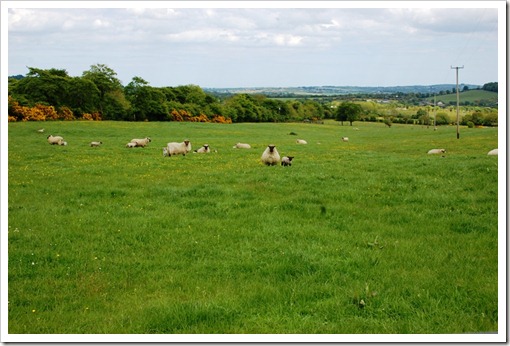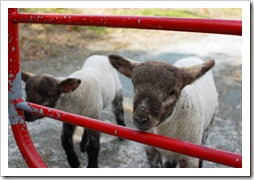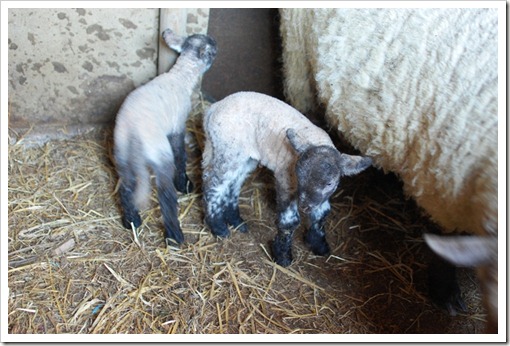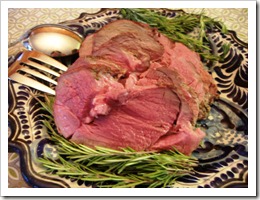Thu 17 Jun 2010
Splendor in the Grass: Irish Country Farms
Posted by Clare under Healthy Food, Irish food, Main Course, Recipes
[2] Comments
 The good life: Sheep graze on Ciara’s farm
The good life: Sheep graze on Ciara’s farm
Being someone who has never lived in the country before, I have a typical urbanite’s image of what a farm is like. The sun is shining, the grass is a deep shade of emerald green and the little lambs and big cows and chubby pigs all play together while being watched over by a talking spider named Charlotte.
Of course the truth is that most animal farms I’ve encountered in the United States are the complete opposite of that fantastical picture I created in my head. The only ones I ever came across were on my drive from Los Angeles to San Francisco, but they were more like factories than farms. Thousands of cows kept in a field of mucky dirt and mud, covered in filth and baking in the hot sun – not exactly a good life (the “Happy Cows” ad series by California Cheese has to be the most blatant example of false advertising I’ve ever seen – these cows are miserable). The “farmers” were actually minimum-wage employees of some big corporation, and I imagine none had any real farming experience or much care for the animals.
It’s a different story where I live now. Though I am in the main town of Drogheda, the area is surrounded by country farms. They are every bit as green and clean and full of adorable animals as the farms I’d conjured in my mind as a city dweller, sans the talking spider. One of my favorite places to visit is my friend Ciara’s farm in Collon, which is only about 10 miles from where I am. She raises lambs and also keeps horses on her picturesque farm, and makes sure all her brood has a good life in ideal conditions. It’s a tough job, and one she takes very seriously.
I recently visited her farm with my friend and fellow expat blogger John O’Sullivan, who had been living in Galway but hadn’t stepped foot on a farm since his arrival in Ireland. As we walked up the road toward the farm, we saw Ciara coming out from the fields sporting her farmer’s attire of jeans, Wellies and a yellow slicker. “We’re lambing right now,” she said, with all her usual cheerfulness. She offered us to take us to look at some newborn lambs, and of course we jumped at the chance. Ciara escorted us to the barn, which housed three lambs and their mother, though only two of the lambs were feeding. The other sported a tourniquet on his back leg and was separated from the rest because, as Ciara explained, his mother had head-butted him as a sign of rejection. This little injured lamb would be cared for by Ciara herself.
For us American folk, this scenario played out like a scene from a sweet after-school special about a kind farmer girl and her little lambs. But reality quickly set in. When John asked Ciara if she had to help birth the lambs, her reply – while given in her usual upbeat manner – was quite sobering. “Oh I just stand there and watch them, because the crows will go after the newborn lambs,” she said. “They dive-bomb the little ones and pull their guts and eyes out, leaving a big mess in the field.” Needless to say, our expressions went from all smiles to looks of absolute horror in two seconds flat. It remained this way as Ciara explained how sometimes she will skin a dead lamb and put its pelt on a rejected lamb so that the mother of the dead animal will take on the rejected one as her own. The thought of this soft-spoken, gentle woman skinning a baby animal evoked a twisted take on the childhood classic, Mary Had a Little Lamb: Mary had a little lamb/Its fleece was borrowed from another dead lamb. *Shivers.*
 On a recent visit to Ireland, my sister meets Juno, the newest member of the sheep-herding team at Ciara’s farm.
On a recent visit to Ireland, my sister meets Juno, the newest member of the sheep-herding team at Ciara’s farm.
As we walked away from the farm, John turned to me and said, “Whoa that was like ‘Silence of the Lambs!’” Of course he was joking around, and we both talked about what an eye-opener it was to spend time at a real farm, where animals are nurtured by a farmer who truly cares about her flock. After spending time with Ciara’s little lambs, it was quite painful to think that in several weeks’ time they would be heading to the abattoir for slaughter. However, I take comfort in the fact that while they are alive they enjoy fresh grass and lots of space to run and the care of a good farmer. While there will be no Charlotte to save them in the end, at least their life – while short – was pleasant.
*I thought it would be a bit morbid to include a lamb recipe after photos of the cute little lambs above, but I also think it’s important to acknowledge where our food comes from.
Roasted Leg of Lamb with Rosemary
(Serves 4-5)
One 3-lb boneless leg of lamb
Coarse sea salt
2 tablespoons of fresh rosemary, minced
3 cups of plain (natural) yogurt
4 cloves of garlic, crushed
More salt and pepper to taste
Have your butcher debone the leg of lamb for you if you do not know how to do it yourself. Truss the meat (tie it with string) so that the meat stays together. Rub all over with the coarse sea salt and rosemary and set aside.
In a large Tuperware container, mix the yogurt and crushed garlic together until well-blended. Place the meat into the mixture and cover; let sit for at least one hour and up to four hours. Preheat the oven to 350 degrees. Remove the lamb from the yogurt and wipe the excess yogurt off the meat with a paper towel. Place on a roasting rack and sprinkle with salt and pepper. Roast for one hour for medium-rare.







Oh man, look at how much the pup has grown since I was last there. So cool that you can keep going out there. Great blog post, too. I tried but couldn’t manage to write a blog about this same thing – it just ended up sounding too macabre everytime I did it.
Yeah, the puppy is SO cute I can barely stand it.